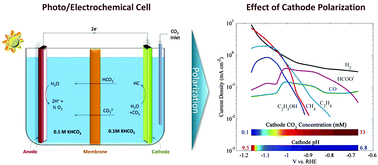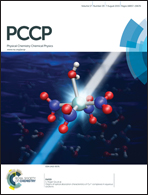Effects of electrolyte, catalyst, and membrane composition and operating conditions on the performance of solar-driven electrochemical reduction of carbon dioxide†
Abstract
Solar-driven electrochemical cells can be used to convert carbon dioxide, water, and sunlight into transportation fuels or into precursors to such fuels. The voltage efficiency of such devices depends on the (i) physical properties of its components (catalysts, electrolyte, and membrane); (ii) operating conditions (carbon dioxide flowrate and pressure, current density); and (iii) physical dimensions of the cell. The sources of energy loss in a carbon dioxide reduction (CO2R) cell are the anode and cathode overpotentials, the difference in pH between the anode and cathode, the difference in the partial pressure of carbon dioxide between the bulk electrolyte and the cathode, the ohmic loss across the electrolyte and the diffusional resistances across the boundary layers near the electrodes. In this study, we analyze the effects of these losses and propose optimal device configurations for the efficient operation of a CO2R electrochemical cell operating at a current density of 10 mA cm−2. Cell operation at near-neutral bulk pH offers not only lower polarization losses but also better selectivity to CO2R versus hydrogen evolution. Addition of supporting electrolyte to increase its conductivity has a negative impact on cell performance because it reduces the electric field and the solubility of CO2. Addition of a pH buffer reduces the polarization losses but may affect catalyst selectivity. The carbon dioxide flowrate and partial pressure can have severe effects on the cell efficiency if the carbon dioxide supply rate falls below the consumption rate. The overall potential losses can be reduced by use of an anion, rather than a cation, exchange membrane. We also show that the maximum polarization losses occur for the electrochemical synthesis of CO and that such losses are lower for the synthesis of products requiring a larger number of electrons per molecule, assuming a fixed current density. We also find that the reported electrocatalytic activity of copper below −1 V vs. RHE is strongly influenced by excessive polarization of the cathode and, hence, does not represent its true activity at bulk conditions. This article provides useful guidelines for minimizing polarization losses in solar-driven CO2R electrochemical cells and a method for predicting polarization losses and obtaining kinetic overpotentials from measured partial current densities.



 Please wait while we load your content...
Please wait while we load your content...